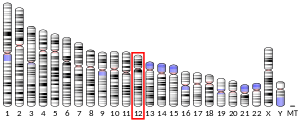KCNC2
Potassium voltage-gated channel subfamily C member 2 is a protein that in humans is encoded by the KCNC2 gene.[5][5][6] The protein encoded by this gene is a voltage-gated potassium channel subunit (Kv3.2).[7]
Expression pattern
Kv3.1 and Kv3.2 channels are prominently expressed in neurons that fire at high frequency. Kv3.2 channels are prominently expressed in brain (fast-spiking GABAergic interneurons of the neocortex, hippocampus, and caudate nucleus; terminal fields of thalamocortical projections), and in retinal ganglion cells.[8][9][7]
Physiological role
Kv3.1/Kv3.2 conductance is necessary and kinetically optimized for high-frequency action potential generation.[9][10] Sometimes in heteromeric complexes with Kv3.1; important for the high-frequency firing of fast spiking GABAergic interneurons and retinal ganglion cells; and GABA release via regulation of action potential duration in presynaptic terminals.[7][8]
Pharmacological properties
Kv3.2 currents in heterologous systems are highly sensitive to external tetraethylammonium (TEA) or 4-aminopyridine (4-AP) (IC50 values are 0.1 mM for both of the drugs).[7][9] This can be useful in identifying native channels.[9]
Transcript variants
There are four transcript variants of Kv3.2 gene: Kv3.2a, Kv3.2b, Kv3.2c, Kv3.2d. Kv3.2 isoforms differ only in their C-terminal sequence.[11]
References
- GRCh38: Ensembl release 89: ENSG00000166006 - Ensembl, May 2017
- GRCm38: Ensembl release 89: ENSMUSG00000035681 - Ensembl, May 2017
- "Human PubMed Reference:". National Center for Biotechnology Information, U.S. National Library of Medicine.
- "Mouse PubMed Reference:". National Center for Biotechnology Information, U.S. National Library of Medicine.
- Haas M, Ward DC, Lee J, Roses AD, Clarke V, D'Eustachio P, Lau D, Vega-Saenz de Miera E, Rudy B (Mar 1994). "Localization of Shaw-related K+ channel genes on mouse and human chromosomes". Mamm Genome. 4 (12): 711–5. doi:10.1007/BF00357794. PMID 8111118.
- Gutman GA, Chandy KG, Grissmer S, Lazdunski M, McKinnon D, Pardo LA, Robertson GA, Rudy B, Sanguinetti MC, Stuhmer W, Wang X (Dec 2005). "International Union of Pharmacology. LIII. Nomenclature and molecular relationships of voltage-gated potassium channels". Pharmacol Rev. 57 (4): 473–508. doi:10.1124/pr.57.4.10. PMID 16382104.
- Gutman GA, Chandy KG, Grissmer S, Lazdunski M, McKinnon D, Pardo LA, Robertson GA, Rudy B, Sanguinetti MC, Stühmer W, Wang X (December 2005). "International Union of Pharmacology. LIII. Nomenclature and molecular relationships of voltage-gated potassium channels". Pharmacol. Rev. 57 (4): 473–508. doi:10.1124/pr.57.4.10. PMID 16382104.
- Kolodin YO (2008-04-27). "Ionic conductances underlying excitability in tonically firing retinal ganglion cells of adult rat". Retrieved 2008-10-20.
- Rudy B, McBain CJ (September 2001). "Kv3 channels: voltage-gated K+ channels designed for high-frequency repetitive firing". Trends in Neurosciences. 24 (9): 517–26. doi:10.1016/S0166-2236(00)01892-0. PMID 11506885.
- Lien CC, Jonas P (March 2003). "Kv3 potassium conductance is necessary and kinetically optimized for high-frequency action potential generation in hippocampal interneurons". Journal of Neuroscience. 23 (6): 2058–68. doi:10.1523/JNEUROSCI.23-06-02058.2003. PMID 12657664.
- Rudy B, Chow A, Lau D, Amarillo Y, Ozaita A, Saganich M, Moreno H, Nadal MS, Hernandez-Pineda R, Hernandez-Cruz A, Erisir A, Leonard C, Vega-Saenz de Miera E (April 1999). "Contributions of Kv3 channels to neuronal excitability". Annals of the New York Academy of Sciences. 868 (1 MOLECULAR AND): 304–43. doi:10.1111/j.1749-6632.1999.tb11295.x. PMID 10414303.
External links
- Kv3.2+Potassium+Channel at the US National Library of Medicine Medical Subject Headings (MeSH)
- KCNC2+protein,+human at the US National Library of Medicine Medical Subject Headings (MeSH)



